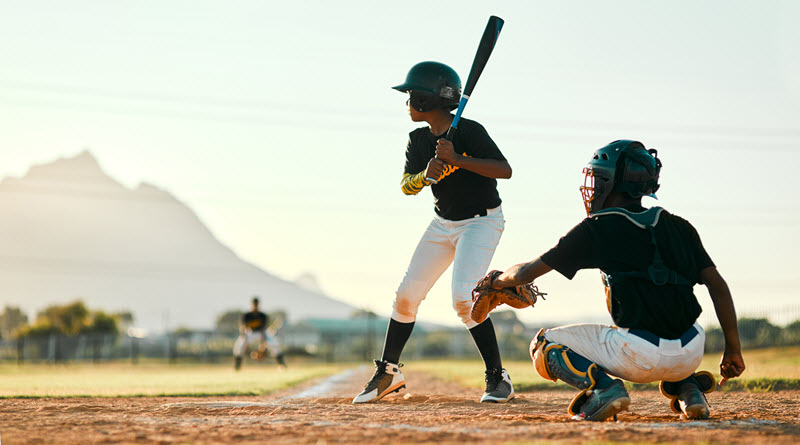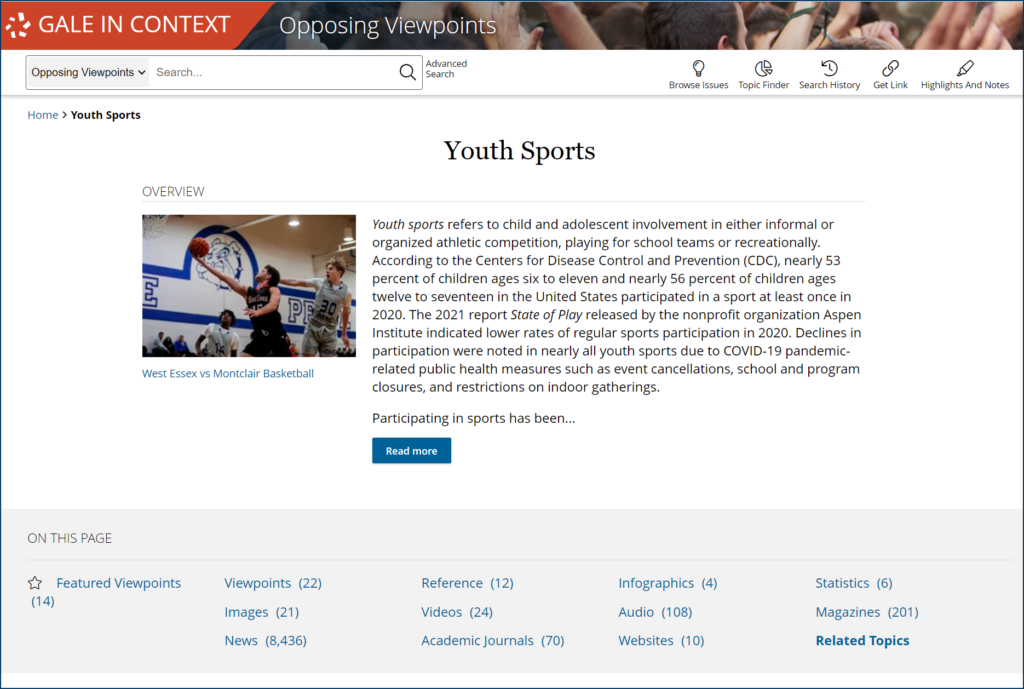| By Gale Staff |
Youth sports programs offer fertile ground for nurturing critical life skills: teamwork, persistence, and pride in one’s accomplishments. However, as teachers, we sometimes see drawbacks. For example, student-athletes may suffer from unrealistic expectations and real or perceived pressure from parents, peers, and coaches. Sports can also create barriers that exclude participants across race, gender, income, and ability.
With summer on the horizon, educators can leverage Gale’s resources to acquire a more balanced view of the potential drawbacks and often-underappreciated benefits of youth sports programs. Through the youth sports topic pages on Gale In Context: Middle School, Gale In Context: High School, and Gale In Context: Opposing Viewpoints, teachers can gain new insights to feel more prepared to manage classroom dynamics and support student well-being when both triumphs and challenges arise.
The Benefits of Youth Sports
Olympic gymnast and four-time gold medalist Simone Biles has said, “A successful competition for me is always going out there and putting 100% into whatever I’m doing. It’s not always winning … Sometimes, it could be, but for me, it’s hitting the best sets I can, gaining confidence … having a good time, and having fun.”
Bile’s words eloquently summarize the ideal outcomes of youth sports: a strong work ethic, self-confidence, and the ability to find joy in overcoming challenges. These qualities don’t just enhance athletic performance; they contribute to academic success and create a more positive classroom environment. When educators recognize and nurture these traits, they help students translate the lessons learned in youth sports into their everyday academic and social experiences.
Improved Mental Health
Have you ever felt the rush following a morning run or pickup game of basketball? If so, then you have first-hand experience of the link between physical and mental health.
While that burst of good feelings is temporary, the long-term positive effects of regular, high-intensity movement are cumulative. Exercising has been shown to improve executive and cognitive functioning while reducing the symptoms of depression, anxiety, and stress.
These benefits of youth sports are particularly compelling, as finding ways to help students manage their mental health is becoming an issue of increasing urgency. The Centers for Disease Control and Prevention’s Youth Risk Behavior Surveillance System has found that between 2010 and 2020, “feelings of persistent sadness and hopelessness—as well as suicidal thoughts and behaviors—increased by about 40% among young people.”
The results of a study of more than 50,000 9th graders give quantitative value to the positive effects of exercise in relation to mental health. Youth athletes report that they were more likely to believe that their parents care a great deal about them, have increased rates of high self-esteem, and were the least likely to report sadness, anxiety, and suicidal behavior.
Foundations for Lifelong Physical Health
Giving children the opportunity to participate in sports sets them on the right track to maintain a more active lifestyle in adulthood.
Obesity affects almost 20% of children and 33% of adults in the United States. While there is a genetic component, it’s also linked to exercise and diet. Multiple studies have shown a direct correlation between sports and maintaining a healthier weight. Adolescents who play three or more sports per year are 27% less likely to be overweight and 39% less likely to be obese.
In addition to helping with weight maintenance, sports encourage healthy heart, lung, muscle, and bone functions while boosting overall coordination and motor skills.
Celebrating Ability Outside of the Classroom
Children with learning-related disabilities face challenges in the classroom that can impact their confidence and self-worth. As they get older, a heightened awareness of their differences can create further stress. However, participating in youth sports is an avenue for both academic and social growth that translates into a win-win situation for both teachers and students.
First, learners get an opportunity to excel outside of an academic setting and naturally learn to build greater resilience in facing educational and social challenges. This experience can directly contribute to their ability to cope within the classroom by teaching critical skills like setting objectives, celebrating achievements, handling defeats with grace, and the value of determination.
Team sports can also address the correlation between learning disabilities and students “express[ing] more loneliness, more victimization, and [being] less social than their non-learning-disabled peers,” as the Learning Disabilities Association of America reports.
Sports are a natural way for children to bond with their teammates over shared goals and experience the joy of collective achievements. In a healthy, supportive environment with caring teammates and coaches, every small success reinforces an athlete’s belief in their abilities. This sense of camaraderie and mutual support can help alleviate feelings of loneliness and build a network of friendships that extend into an academic setting.
Athletic and scholastic pursuits are partners, not adversaries, in fostering student success. For students with learning disabilities, this connection is even more significant, as sports can offer a sense of belonging and achievement that they may not experience in the classroom.
The Drawbacks of Youth Sports
While there is empirical evidence supporting children’s participation in sports, there is nuance to the topic that we may be less aware of. Increased longitudinal research into the impact of youth sports and awareness of diversity, equity, inclusion, and belonging (DEIB) issues has drawn more attention to the potential long-term effects that a negative experience with sports can have on children.
Prohibitive Financial Commitments Lead to Feelings of Isolation
After the Miami Heat became the sixth team in NBA history to win back-to-back championships, Lebron James—who was raised in the inner city by a single mother—stated, “I’m not even supposed to be here.” Critical responses to this observation argued that sports, specifically basketball, have always been a way for city kids to escape poverty. However, the statistics disagree.
Harvard economist Seth Stephens-Davidowitz found that NBA players were now more likely to have grown up in homes in the top 40% of income rather than in low-income neighborhoods.
The impact of these barriers is further illustrated by Project Play’s State of Play 2022 report, which found that families spend an average of $883 on one child’s primary sport. These costs go toward covering registration fees, travel, summer training camps, equipment, and more. For children from lower socioeconomic households, these prohibitive costs not only cause “children in the U.S. [to have] different sports experiences based on money” but also prevent many low-income families from having a chance to participate at all.
Teachers may see the consequences of this financial disparity manifest as feelings of isolation for students who are unable to participate in youth sports. They may feel excluded from peer groups and miss out on the social and developmental benefits that come with being part of a team.
Recognizing these financial barriers that their low-income students face, educators can encourage activities that promote teamwork and social interaction without financial burden. Even putting aside time each week for group projects, inclusive games, and outdoor play can help students form connections and feel a sense of belonging.
Performance Pressure
During an interview with “All Things Considered,” Mark Hyman, the author of Until It Hurts: America’s Obsession with Youth Sports and How it Harms Our Kids, distilled the overall message of his book into a poignant quote:
“I think that the problems arise when we … lose sight of the fact that … sports for kids is not a career path. It’s not a stepping stone to some … greater goal, financially or otherwise, or even a college scholarship. So, I think we’ve constantly got to be re-evaluating whether child sports activities are about them or about our ambitions for them.”
This pressure to perform doesn’t just come in the form of the stereotypical “screaming parent in the stands.” Hyman, who describes himself as a “fairly reasonable” parent and youth sports coach, said that he still regrets the day that his then-14-year-old son and team pitcher came to him about shoulder pain. Pressure from the upcoming playoffs saw the author put his son on the mound three days later, only to pull him out after just six pitches as the injury became obvious.
Whether it’s pressure coming from parents, coaches, or themselves, young athletes often find themselves pushed past their breaking point. Even when the issue isn’t physical, the stress and anxiety that come from the constant drive to win can completely overshadow the fundamental reasons for playing in the first place: enjoyment and personal growth.
When student-athletes face pressure from all sides, teachers can provide a safe space for kids to fail, vent, and express their disappointment without fear. There’s an opportunity to encourage students to have a more balanced view of sports and not just as a means to an end. For example, a respected teacher publicly acknowledging the student’s effort and dedication in front of their peers after a heart-breaking loss can have a huge impact. It also models to students how meaningful a kind word can be when a peer feels defeated.
For more information about youth sports or to explore materials covering thousands of other topics relevant to teaching and learning, turn to Gale In Context. Our collection of databases provides unprecedented access to one of the largest collections of curated, quality content approved by educators for use in classroom settings.


